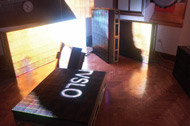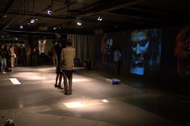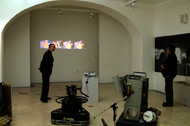sen/za videogram 4
Dreaming About/Without Television
"If you believed they put a man on the moon, man on the moon.
If you believed there's nothing up their sleeve, then nothing is cool."
Andy Kaufman/ REM
Forty years have passed from Neil Armstrong’s first steps on the surface of the moon. This was the first event known to the majority of the population on our planet solely by the media. Therefore, it became a synonym for the power of media and the mistrust of it. First human steps on the moon marked the beginning of a new sort of reality, a mediatised reality. As such, they determined the everyday life of humans much more than the very act of walking on the moon, by which the human beings surpassed themselves. We live and act according to what we learn from the media, yet simultaneously, our experience tells us that we shall not trust the media. This split that 20th century theoreticians interpreted in different ways is the fundamental experience of the modern human being. While at the 40th anniversary of the first landing on the moon, the big media tried to conceal this doubt, other anniversaries remind us of that. One of them is the 30th anniversary of the project Videogram 4 by Miha Vipotnik, which was one of the first results of this twofold, divided attitude. Wishes and renunciations. Dependences on television and at the same time fear of it. These are the themes of the project by which Miha Vipotnik in 2009 marked the 30th anniversary of Videogram 4. Sen-za-tv: Dream for Television without television (Senza televisione).
Videogram 4, 1979, intro part
Medium as a Memory Carrier
Jakopič Gallery, Monday, 4th May 2009. It is 19:00. Olga Rems, the television moderator who marked the Slovene public television from its very beginnings, addresses the viewers, announces the experimental television satellite broadcast of the Sen za televizijo programme, and invites the audience to control the time of the vertical pulsation of the television image. She introduces Bojan Gorišek who sits by the piano and plays Philip Glass, while the lady in red coat is preparing in front of the camera for her performance; the visitors walk around the gallery crossing the visual camera fields and projection surfaces. Following Gorišek, Primož Urbanč presents his piece Nam June Paika Piano (1982).
At 20:00, the scene connects over projection canvases with the happening in Kapelica Gallery where Nova deViator / Luka Prinčič execute their opening performance at the 40th anniversary of Radio Študent. The connection with Radio Študent fails: it works over the internet cable only one way, people present in the gallery hear and see the people from Radio Študent but can speak to them only over the phone. Then Olga Rems announces the performance of the original Videogram 4 actors: Maja Boh, Andrej Trobentar and Dušan Rogelj. The Jakopič Gallery is robed in the dark; the bodies of performers again become both holders of their individual movements and projection surfaces for light beams emitted by projectors and screens. The event is broadcasted by satellite but not by television. The next day an exhibition opening takes place in the Vžigalica Gallery where numerous screens show the project’s upgrade with audiovisual manipulations by Luka Dekleva and Luka Prinčič, together with archive recordings and restored video tapes, documentary photos from studio RTV Ljubljana as well as documents and devices from the time of the original formation of the Videogram 4 project.
Sen za televizijo is performed without television and at the same time presents the dimension, which television conceals as a rule: the look to the backstage, the process of commencement. Actually, Vipotnik combines two processes in his project, both typical for art which does not deny its involvement in society but derives from it and simultaneously presents itself as a symptom of the circumstances of its origin and its critique. On the one side, he offers a discussion about the assigned elements − television, video, painting art as his basic approach, and about his own projects, e.g. Videogram 4. On the other, he offers an insight in the very processes of media art in his work − in the sense of creation proceedings leading to the origin of an artwork by the artist as well as in the sense of reception proceedings accomplishing the artwork by the audience. In both cases, he creates a critical relation towards a romantic perception of creating from nothing and confronts it with art as a process. In the second part of the project Sen za televizijo, as he stated on the website, presents "the archaeological approach to researching the medium that acts as a memory carrier. Apart from the preserved single channel tape, the saved video tapes that were used at the original project will be used to make new recordings that will show new levels and angles. /…/ With the new project the author can never (nor does he wish to) create an exact replica of a past event. /…/ The project will thus not be merely a reconstruction of a past event, but also its expansion, continuation and re-enactment that will see the light of day in a different context."
Selection from the Menu
Today, the idea of the medium as a memory carrier is more relevant than ever. By digitisation, all human creations in image, sound and word are directly accessible, so to speak: everywhere, immediately and regardless of the time of origin. The media landscape is increasingly self-reflexive. In conditions where media contents are designed, preserved and spread by one single device − the computer − the taking of elements from already existent contents becomes increasingly simple. Selection is the basic operation of computer culture. Only rare works are made out of nothing; usually they are composed of henceforth-prepared elements. In computer culture, authentic creation is replaced by menu selection. Artists choose from the library of three-dimensional models, sounds, images. Henceforth-prepared elements are the components of computer programme menus; the worldwide web is a new source of these supplements and ready elements. Like artists of computer culture, users too are invited to select from the menus, either by using programmes for creating documents or by accessing internet services. We choose among henceforth-defined styles in text editing, among henceforth transparency forms of computer presentations, among henceforth-defined avatars by entering multi-user worlds, such as Second Life. Selection is the basic operation of professional media producers as well as end users. Thus, the production process is more efficient for the first and gives the end users the feeling of not being merely a consumer but an author creating new media contents or experiences.
One could say that there is a special relationship between standardisation and inventiveness, which however is not utterly new, since this kind of authorship can be found in old media as well. Finally yet importantly, the romantic ideal of an artist who creates out of nothing, who tears images directly out of his/her imagination or invents new ways of perceiving the world was questioned even by art history itself. L'homme qui marche (1974) by Albert Giacometti depicts the human body entirely differently from the L'homme qui marche (1877−1878) by Auguste Rodin, while both differ from the way Michelangelo portrayed David (1501−1504). When presenting the nature, the artist too leans on existent representation schemes that have been changing throughout history.
The selection as a creative operation is put into effect more explicitly in the 20th century, when culture production became a mass and automated activity. The avant-gardists were the first to oppose the handicraft model of creation that traditional artists persist in, and started to create their works with collages and assemblages by using existent culture elements. This was the beginning of the industrial method in production art. Photomontage became an asserted practice of Dadaists, surrealists, constructivists, and later pop artists. Above all, in present Slovenia creating out of nothing − e.g. painting and drawing − remains the central activity of fine art. Electronic art which from the very beginning was based on a new way of creation − namely, changing the existent signal − started to implement changes that captured the entire present culture.
In 1920, Russian scientist and musician Lev Theremin designed a generator that produced a sine wave, while the creator changed its frequency and strength. The artist became a technician who created by turning and pushing buttons. Later, the sine wave was replaced by signals that are more complex: sounds, rhythms and melodies. Adding a multitude of signal generators, we get a modern music synthesizer, the first instrument that embodies the logic of computer media: the selection from the menu of possibilities. The first music synthesizer was made in the 1950ies, the video synthesizer ten years later; the 1970ies brought a collection of effects used by video editors (Digital Video Effects, DVE), and the 1980ies introduced computer programmes, which next to creation as a process fetched a collection of basic forms.
The time of video synthesizer and DVE is the time of the origin of Videogram 4. Miha Vipotnik, although a painter, does not create out of nothing but starts to exploit the ways of creation offered by television in a way that he searches for alternative usage of its technologies and at the same time already uses computers.
He records the event on multiple tapes so that he changes the signals during recording and later changes and combines the created recordings during performing. He modifies the television oscilloscope for a usage that quite resembles the later VJ effects and instead of the so-called character generator uses a personal computer for text editing, which back then RTV Slovenija did not yet posses, but it was on the market. The recording of Videogram 4 preserved up to the present is thus only one of many varieties of this work.
Signal Modulation
Changing the signal, a technical foundation for understanding the artwork as a process, is one of the essential procedures of Vipotnik’s work. In fact, this procedure spreads only decades after Videogram 4,in the era of computers when it is represented by filters. During the creation of media contents, artists use different filters regarding either the alteration of the image appearance, the crossing between motion images or the use of the filter for music. The principle is the same with all filters − an algorithmic change of the existent media content or its part. Computer media consist of basic units (samples), which in the computer are represented by numbers. Thus, the computer programme can access each sample separately and change its value according to the algorithm. The changing of the image in Photoshop, for example, works like this: the programme reads the image from pixel to pixel, changes the value of the chosen pixels and writes a new file for the image.
As I said, the scheme for filtration was found in electronic media of the 19th and 20th century, which were based upon the changing of the signal. This holds for the telephone, a real time communication, for technologies for broadcasting media contents, such as radio and television, as well as for technologies for synthesizing media contents, like video and sound synthesizer. The transition from the material subject to the signal actually happened with electronic technologies. There exists no lasting record in a matter, since the signal can be changed in real time. Contrary to the manual change of a material subject, the electronic filter changes the entire signal at once. Therefore, the signal does not have a single identity in the sense of a certain state that in quality differs from other possible states. This is well illustrated by buttons for changing the sound volume on the radio or changing the brightness on an analogue television. A consequence of this is that there are no privileged states and values.
The persistence of television in presenting news, broadcasts and programme blocks, in short concluded units, is understandable regarding its cultural role as a carrier of information with special value. From the technical point of view, it is an anachronism, since television as an electronic medium is based upon the changeability of the signal. Vipotnik uses it this way in Videogram 4, and in other projects. Pointing to the fact that the cultural use of television opposes its potentials is a constant in Vipotnik’s work who persistently presents his use of new technical possibilities as television, ranging from understanding the medium as an archive to the artwork as a process. This applies to his development of a radical use of its media potentials within the television as an institution (like in the work Videogram 4) as well as to his activity outside the television’s formal frames, like in the case of the project Sen za televizijo.
With the transition from analogue electronics to digital computers, the range of variations gets even bigger. Firstly, because modern digital computers divide the software from the hardware. Secondly, because media contents now have the form of computer data that can be changed with software. Analogue television has been already enabling the change of signal. Thus, a computer user has even more possibilities: for example, he/she can define in the browser to avoid all multimedia subjects, to increase the size or even change the type of characters while downloading a certain page, to change the size of the window, the colour and spatial elements of the display. Thus, a new media content actually exists in many varieties and numerous materialisations.
This demands a different author, someone for whom not designing final subjects but changing and constructing combinations is essential. A model for this new author is the DJ who creates music the way he/she links and intertwines already existent music pieces and in this uses different electronic devices. The rise of the DJ who in the 1990ies reached a special cultural reputation was synchronic to the rise of computer culture. The DJ’s work represents best the new logic of creation as a selection and combination of henceforth-existent elements and at the same time proves the potential of the logic of creating new artworks. It namely shows that selection itself is not enough; the essence of the DJ’s art is to search constantly for new ways of combining selected elements.
Sen za televizijo
Therefore, it is logical that Vipotnik conceived Sen za televizijo as a project in which he combines and intertwines recordings and happenings on different scenes in real time. It is also logical that in the project’s upgrade he invited a DJ for collaboration. Next to the very nature of the creation process within digital media, which in many ways is represented in the DJ’s activity, this has broader dimensions. On the one hand, the artist supplements his/her authorial poetics, which, like the entire artwork, treats the human voice as a changing signal constantly subordinated to transformations in the process of creation as well as in electronic processing.
Emphasizing the processual nature of art also consolidates the political connotations of his critique of the media. It namely shows how electronic media by denying their changeable nature contribute to the preservation of obsolete cultural paradigms, ranging from the romantic idea of an individual artist to the artwork as a completed work. At the same time, the concealment of processes that Vipotnik himself puts to the view in his television works enables the media to discharge the functions of authority executors.
Vipotnik’s presumption that the technical intangibility of the television production process indicates authority relations might be exaggerated. Its relevance is well illustrated in a scene from the film Man on the Moon from 1999. The famous American concrete comedian Andy Kaufman (Jim Carey) as his alter ego, Tony Clifton, persists on performing several seconds of noise, the so-called snow on the television screen, in a show he prepared for a big television network. After lasting negotiations, the network management finally agrees, but is still surprised by the screen snow despite its announcement. The network president reacts as if it would be a direct threat in the sense: "Something like this cannot happen to us."
The film, directed by Miloš Forman, presents Andy Kaufman as one rather lucid critic of the American media; the thesis that one cannot believe the media reports about landing on the moon was supposed to be a part of this critique. Therefore, the project that Vipotnik set up at the 30th anniversary of Videogram 4 and only a few weeks before the 40th anniversary of the landing on the moon is an occasion for reflecting upon the actual extensions of video art. Especially, if he emphasizes the technical possibilities of his medium, it is clearly an art of transition. It is a critique of old, analogue media that have not exploited their potential and the announcement of options that have spread not earlier than with computers. As shown in the work by Miha Vipotnik, video art can too be a critique of dominating media in which electronic as well as computer media succumb to obsolete paradigms.
Melita Zajc



